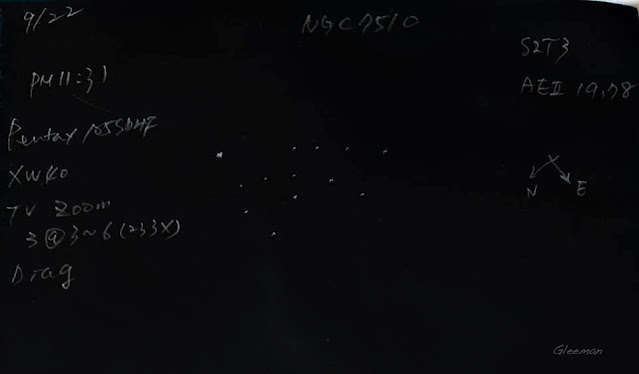Further statistical chart analysis of my visual observations and sketches of 300 deep-sky objects at Anbu(part 3)Observation of Clusters
疏散星團的眼視觀測
Observation of Open Clusters
由於觀測疏散星團屬於點光源與觀測星雲星系等有面積天體(extended objects)不同,放大倍率並不會影響點光源亮度,但可以增加望遠鏡的極限星等(天空亮度變暗),所以盡可能地拉高倍率是觀賞疏散星團裡更多成員星的方式。
把疏散星團的視星等與觀測紀錄中望遠鏡目鏡視野中的極限星等做圖表比較。顯示出很有趣的關係。
observing open clusters is different from observing extended objects such as nebulae and galaxies,magnification does not affect the brightness of point light sources, so can increase the limiting magnitude of the telescope (the sky becomes darker), so increasing the magnification as much as possible is a way to see more member stars in open clusters. Compare the apparent magnitude of open clusters with the limiting magnitude of the telescope in the observation record, It shows a very interesting relationship.
首先可以清楚看見,望遠鏡的極限星等都要比視星等暗,當然這是必然的,因為視星等是總亮度,個別的成員星都比這要暗。
注意圖表最右側,觀測時望遠鏡倍率放大後的視野極限星等達13等的NGC 6989, NGC6939以及NGC 7510三個星團,這三個星團可以用來測試觀測環境、十公分望遠鏡的極限以及你的眼睛的極限。我使用Pentax 105SDHF放大至233倍,出瞳徑只剩0.45mm算是接近十公分望遠鏡與眼睛的極限了。
First of all, it can be clearly seen that the limiting magnitude of the telescope is darker than the apparent magnitude. Of course, this is necessary because the apparent magnitude is the total brightness of the cluster and individual member stars are darker than this.
Note the far right side of the chart. The NGC 6989, NGC6939 and NGC 7510 clusters with a limiting magnitude of +13. when observed with a magnified telescope, three clusters that can be used to test observation conditions, the limits of a ten-centimeter telescope and your eyes’ dark adaptation. I used Pentax 105SDHF to magnify to 233x, and the exit pupil was only 0.45mm, which was close to the limit of a ten-centimeter telescope and eyes.

另外,請看望遠鏡極限星等接近13時觀測的NGC 559,NGC 559是位於仙后座的一個疏散星團,在著名的W形附近,視星等為+9.5。我在觀測NGC 559中使用了兩種倍率,顯然低倍時極限星等只有到11.7左右是不太夠的,NGC559中最亮的恆星視星等為10.5等。但要到極限星等達 +11.7 等時才能看到第三顆成員, 而要看到十顆約要13等 (13-9.5=3.5),也就是極限星等要比視星等暗3.5等。這個數值很接近一般的狀況。
In addition, please see NGC 559 observed when the limiting magnitude of the telescope is close to +13. NGC 559 is an open cluster located in Cassiopeia near the famous W shape with a apparent magnitude of +9.5. It is a II2p type open cluster. I used two magnifications when observing NGC 559. Obviously, when using low magnification, the limiting magnitude is only about 11.7 which is not enough. The brightest star in NGC559 has a apparent magnitude of +10.5 . However, it takes a limiting magnitude of +11.7 to see the third member, and about ten members need to reach magnitude +13 .(13-9.5=3.5), which means that the limiting magnitude must be 3.5 magnitudes darker than the apparent magnitude of the cluster. This value is very close to general conditions.
看一下另一個視星等同樣是9.5等的NGC 6268,它是位於天蠍座的一個疏散星團,在天蠍後腹第一節的附近,星團大小約為6角分,包含約150顆恆星。望遠鏡極限星等達+10.8時可見三顆,當達到11.6 等時能見十顆(11.6-9.5=2.1),只比視星等暗兩等,算是成員比較接近視星等的了。
Take a look at another open cluster with a apparent magnitude +9.5.NGC 6268. It is an open cluster located in Scorpio near the first section behind Scorpio’s abdomen with a size of about 6 arc minutes and contains about 150 stars. When the limiting magnitude of the telescope reaches +10.8, three member stars can be seen, and when it reaches +11.6, ten can be seen (11.6-9.5=2.1), which is only two magnitudes darker than the apparent magnitude and is considered to have more members concentrated at brightness close to the apparent magnitude of the cluster.
另一個觀測時極限星等也比較接近視星等的是NGC 6997 (6996),NGC 6996是在天鵝座的北美洲星雲內的一個疏散星團, 視星等+10。觀測時使用的極限星等約在12.4。當極限星等達 +11.1 能看到三顆,而11.5等以上已可見十顆,只比視星等暗了1.5等(11.5-10=1.5),算是少數星團成員集中於比較接近視星等的。
Collinder 316也是類似NGC6996成員星集中於較亮星等的疏散星團,它的視星等6.6等,當極限星等達8.5等以上已可見約30顆成員星。
Another observation where the limiting magnitude of telescope is closer to the apparent magnitude of cluster is NGC 6997 (6996). NGC 6996 is an open cluster within the North American Nebula in Cygnus with a apparent magnitude of +10. The limiting magnitude I used during observation was about +12.4. When the limiting magnitude reaches +11.1, three can be seen, and above +11.5, ten can be seen already, which is only 1.5 magnitudes darker than the apparent magnitude of the cluster(11.5-10=1.5), which is one of few clusters where members are concentrated closer to apparent magnitudes of the cluster.
Collinder 316 is also an open cluster similar to NGC6996 where member stars are concentrated at brighter magnitudes. Collinder 316 has a apparent magnitude of +6.6, when the limiting magnitude of telescope reaches above +8.5 about thirty member stars can already be seen.
比較一下成員較暗的,例如M52,觀測M52時我用了三種倍率,這圖表上僅顯示了其中最高倍,也是最適合的,使用140倍。Messier 52疏散星團位在仙后座視星等 6.9,最亮的成員是8.2等的雙星BD+60 2532, 但極限星等要比視星等暗2.8等達+10.7以上始可見三顆。達11.2等以上可見十顆成員 (11.2-6.9=4.3),已比視星等暗了4.3等。
Comparing members who are darker, such as M52, I used three different magnifications when observing M52 and only showed one record on this chart: highest magnification and most suitable at 140x magnification. Messier 52 open cluster located in Cassiopeia has a apparent magnitude of +6.9 and its brightest member is BD+60 2532 double star at magnitude +8.2 but it takes a limiting magnitude that is darker than its apparent magnitude by 2.8 magnitudes reaching above +10.7 before three members can be seen, ten when reaching above +11.
再看M46,視星等6.1,但望遠鏡極限星等要達10.5等以上始可見10顆,比視星等要再暗上4.4等。
大致來說,如果要能夠看到疏散星團的三顆成員以上,通常至少要比視星等暗上1~3個星等,視星團的特性。而如果要能看到十顆成員以上,建議極限星等至少比視星等暗四個星等以上尤佳,這張圖表顯示觀測疏散星團時使用的極限星等與該天體的視星等的關係,雖然觀測時沒有刻意去注意它們的視星等,但統計圖表很自然地顯示絕大部分的觀測都遠優於上述的條件。
除了少數只比視星等暗兩個多星等就能看到二、三十顆成員星的亮星團,一般來說當使用的極限星等超過視星等有6等之多的,大多已經可以解析數十顆星了,如我很喜愛的M6, M7,繁星點點又是另外一種風景了。
When observing M46 with a apparent magnitude of+6.1, the limiting magnitude of the telescope must reach above +10.5 before ten members can be seen, which is 4.4 magnitude s darker than the apparent magnitude.
Generally speaking, if you want to be able to see more than three members of an open cluster, you usually need to be at least 1-3 magnitudes darker than the apparent magnitude depending on the characteristics of the star cluster. If you want to see more than ten members, it is recommended that the limiting magnitude be at least four magnitudes darker than the visual magnitude.
This chart shows the relationship between the limiting magnitude used when observing open clusters and the apparent magnitude of the cluster. Although I did not deliberately pay attention to their visual magnitudes during observation, the statistical chart naturally shows that most observations are far better than the above conditions.
Let's take a look at the use of limiting magnitude that exceeds apparent magnitude by as much as 6 magnitudes. This allows the resolution of several tens of stars, such as the ones I really like, M6 and M7, where the abundance of stars creates a unique and beautiful scene.












.jpg)












沒有留言:
張貼留言
歡迎留言分享指教 feel free to leave your message
(目前設定為需有google帳戶才能留言)